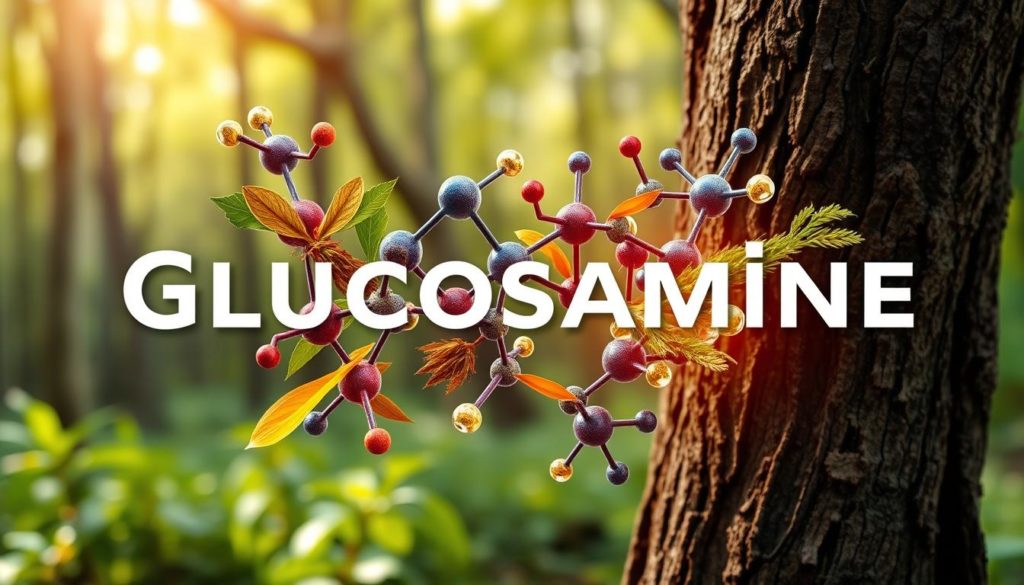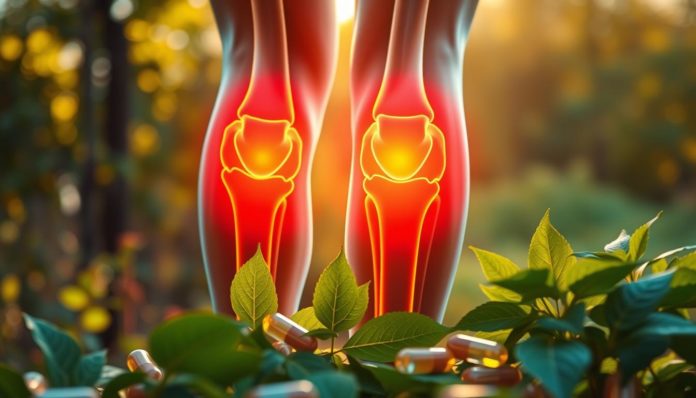Did you know over 50 million Americans deal with joint pain every year? This fact shows we need good solutions fast. Glucosamine is a natural compound making a splash in joint health.
People recognize glucosamine for easing joint pain and being a natural fix. It helps with the annoying pains of arthritis or boosting overall joint health. Glucosamine could become your go-to helper.
Understanding Glucosamine and Its Role in the Body
Glucosamine is key in our bodies. It helps build and take care of cartilage, which keeps our joints working smoothly. Knowing how it works helps us understand its importance for joint health.

What is Glucosamine?
Glucosamine comes from shellfish or made in labs. It’s a type of amino sugar that’s vital for making cartilage. It helps form important proteins and fats needed for body functions, including fixing cartilage.
How Glucosamine Supports Joint Health
Glucosamine’s main job is to help fix cartilage. It does this by helping create materials essential for cartilage’s structure and working. This lessens joint pain and swelling, making movement easier.
When you take glucosamine regularly, it can boost joint health over time. This makes glucosamine a top pick for those wanting to stay active and healthy.
| Function | Benefits |
|---|---|
| Cartilage Repair | Supports synthesis of glycosaminoglycans, aiding in cartilage maintenance |
| Joint Health | Reduces pain and inflammation, enhancing mobility |
| Natural Compound | Derived naturally, often from shellfish or produced synthetically |
Benefits of Glucosamine for Joint Health
Glucosamine is well-known for helping joint health. It helps people manage joint issues better and boosts their life quality.

Easing Joint Pain
Glucosamine is great for easing joint pain. Research shows it lessens pain for those with arthritis or similar issues. It’s a natural way to handle joint pain without using drugs.
Reducing Joint Inflammation
Reducing joint inflammation is another key benefit. Long-term inflammation harms joints over time. Glucosamine fights this by protecting the tissues, helping prevent more severe conditions like osteoarthritis.
Supporting Cartilage Repair
Cartilage keeps joints working smoothly, but it can wear down. Glucosamine aids in fixing cartilage, keeping joints healthy. Regularly taking glucosamine helps keep cartilage strong, preventing damage.
| Benefits | Impact on Joint Health |
|---|---|
| Joint Pain Relief | Reduces discomfort in joints, especially in cases of arthritis. |
| Joint Inflammation Reduction | Lowers chronic inflammation, protecting joint tissues. |
| Cartilage Health | Supports the repair and integrity of cartilage, preventing degeneration. |
The key benefits of glucosamine are easing joint pain, reducing inflammation, and supporting cartilage repair. These make it a top choice for maintaining good joint health.
Glucosamine and Osteoarthritis
Osteoarthritis affects millions around the world. It damages cartilage, leading to pain, swelling, and less movement. Many studies look at how glucosamine might help manage symptoms and slow the disease.
Glucosamine is known for helping repair cartilage. This helps keep joints working well. Many research findings suggest it eases joint pain and stiffness, big issues in osteoarthritis.
Using glucosamine regularly may slow osteoarthritis’s advance. This could make life better for patients, letting them keep up with daily tasks more easily. Regular use is key to enjoying these benefits over time.
Health experts often suggest glucosamine as part of wider osteoarthritis care. This approach usually includes other supplements, therapy, and lifestyle adjustments. These steps aim to boost joint health and lessen symptoms.
Remember, it’s wise to talk with a healthcare provider before trying new supplements. They can make sure glucosamine fits well with your other treatments. This ensures your health needs are met accurately.
Popular Glucosamine Supplements
There are many glucosamine supplements on the market. Finding the right one can be hard. They come in different forms, each with its own benefits. Understanding these can help you choose the best for your joints.
Forms of Glucosamine Supplements
Glucosamine supplements come in various forms:
- Pills: The most common form, offering convenience and precise dosing.
- Powders: Easily mixed with beverages, providing flexibility in consumption.
- Liquids: Often claimed to have higher bioavailability for better absorption.
It’s important to think about how well your body can absorb these forms. Pills are usually more stable. But, powders and liquids can be absorbed quicker. This makes them a good choice for those who want fast relief.
Choosing the Right Supplement
When picking a glucosamine supplement, think about these things:
- Quality of Ingredients: The product should have high-quality glucosamine, with no unnecessary fillers.
- Manufacturing Standards: Choose products made in facilities that follow Good Manufacturing Practices (GMP). This helps ensure they are safe and work well.
- Form of Glucosamine: Pick the form—pills, powders, or liquids—that fits your lifestyle and preference.
Also, looking at customer reviews and third-party certifications can help. They can tell you if a product is effective and reliable. By thinking about these points, you can find the best glucosamine supplement for your joints.
Natural Sources of Glucosamine
Many people look for natural glucosamine sources to improve their joint health without just using supplements. Finding these foods can help boost your health plan.
Shellfish shells are a key source. They’re ground into powders and used in meals. This provides a good amount of glucosamine, which helps with joint health. Mushrooms, like shiitake and maitake, also offer glucosamine. They’re great for your joints.
Animal bones can be used to make broths and soups. Cooking bones slowly releases glucosamine into the broth. Adding these natural sources to your diet helps support your joints.
| Natural Source | Glucosamine Content | Benefits |
|---|---|---|
| Shellfish Shells | High | Aids in joint lubrication and reduces pain |
| Mushrooms (Shiitake, Maitake) | Moderate | Supports cartilage health |
| Animal Bones (Bone Broth) | High | Enhances joint flexibility and cushioning |
When comparing natural sources with supplements, it’s clear natural options offer more. Besides glucosamine, they provide other nutrients and benefits. This is perfect for those seeking a well-rounded joint health diet.
Glucosamine vs. Other Joint Health Supplements
In the world of joint health, people often compare glucosamine to other supplements like chondroitin and MSM. These supplements each bring unique benefits for maintaining joint health and easing pain.
Comparing Glucosamine and Chondroitin
For osteoarthritis management, glucosamine and chondroitin are top choices. They help cushion the joints, easing pain and stiffness. Research shows they might work as well as some NSAIDs, like celecoxib, but with fewer side effects.
The Arthritis Foundation says using them together could be especially good for knee pain.
Glucosamine and MSM
MSM stands out in joint care too. When used with glucosamine, its anti-inflammatory effects can lessen joint pain. The combo of glucosamine and MSM might improve joint function and mobility better than using each alone.
This shows a full approach to taking care of joint health and managing pain.
Here is how these supplements stack up:
| Supplement | Benefits | Known Efficacy |
|---|---|---|
| Glucosamine | Supports cartilage repair, reduces pain & stiffness | Strong |
| Chondroitin | Cushions joints, reduces osteoarthritis pain | Moderate-High |
| MSM | Anti-inflammatory, reduces joint pain | Moderate |
The comparison of joint supplements shows how each one is useful. Using glucosamine with chondroitin or MSM could give better relief and joint health. Always check with a healthcare expert before starting a new supplement.
How to Take Glucosamine for Maximum Benefits
To make glucosamine work best, knowing the right dosage and when to take it is key. These steps help support your joints effectively.
Recommended Dosage
Adults should generally take 1,500 milligrams of glucosamine each day, divided over several doses. But, it’s important to talk to a doctor to find the right amount for you. Your age, weight, and joint issues can change the dosage you need.
Best Time to Take Glucosamine
Giving thought to when you take glucosamine can affect how well it works. Although no fixed time is best, taking it with meals or right after can help. This approach lowers the chance of stomach issues and improves absorption.
- Taking glucosamine with meals: Helps minimize digestive discomfort.
- Spreading doses throughout the day: Ensures steady levels in the bloodstream.
- Consistency: Integrate glucosamine into your daily joint health regimen for optimal results.
Potential Side Effects of Glucosamine
Glucosamine is well-known for aiding joint health, but it’s vital to know its side effects. Some people might have mild side effects like nausea, diarrhea, or constipation. More serious issues such as liver damage and insulin problems are rare. Knowing the risks of glucosamine is essential for anyone taking it.
Talking to a doctor before starting glucosamine is wise. It’s important to know how it might interact with other meds you’re taking.
Here’s a quick list of possible side effects from glucosamine:
- Nausea
- Diarrhea
- Constipation
- Hepatotoxicity
- Insulin Resistance
For deeper insights, check out WebMD’s glucosamine guide. It offers more on research and studies related to this supplement. Being informed helps you stay safe while taking care of your joints.
Customer Reviews and Experiences with Glucosamine
Seeking better joint health, many turn to supplements like glucosamine. We’re diving into glucosamine customer reviews to shed light on its true benefits.
Positive Reviews
Glucosamine has earned praise for boosting joint health. Users often report less joint pain and more flexibility. For example, someone said that after a month of glucosamine, their knee pain decreased, and they exercised more.
It’s also known for aiding cartilage repair. People say regular glucosamine use has revived their joints, improving their lives greatly.
Negative Reviews
However, glucosamine doesn’t help everyone. Some glucosamine customer reviews show no pain or mobility improvements after extended use. One individual mentioned no relief from arthritis symptoms despite three months of trying.
Another issue is side effects. A few users talked about stomach problems or allergic reactions. So, while glucosamine benefits many, it’s wise to weigh both sides.
| Aspect | Positive Reviews | Negative Reviews |
|---|---|---|
| Pain Relief | Significant reduction in pain | No noticeable change |
| Mobility Improvement | Enhanced mobility and flexibility | No effect |
| Side Effects | Minimal or none | Gastrointestinal issues, allergic reactions |
| Cartilage Repair | Encourages cartilage health | No improvement noticed |
Where to Buy Glucosamine Supplements
Looking for the right place to get glucosamine supplements is key for their quality and how well they work. It’s smart to pick stores known for their reliable joint health items. Places like GNC, The Vitamin Shoppe, and Walgreens are good options. They are known for good health products and have experts to help you.
For those who like shopping online, sites like Amazon, iHerb, and Vitacost are great. These sites have user reviews that show how well products work. Always look for proof of quality, like third-party testing, when shopping online to get real and safe items.
Buying straight from the product’s official site can also have perks. You might find discounts, join loyalty programs, and get help from customer support. No matter where you buy your glucosamine, always read reviews and check the product’s realness. Also, talk to a doctor if you’re unsure about adding new supplements to your routine.
FAQ
What is glucosamine?
Glucosamine is found in cartilage, the tough tissue in our joints. You can also get it as a supplement. People use it to keep joints healthy and help with osteoarthritis.
How does glucosamine support joint health?
It makes certain proteins and lipids that help fix and keep up cartilage. This might make joints move better and hurt less.
What are the benefits of glucosamine for joint health?
Glucosamine can ease joint pain, lessen inflammation, and help fix cartilage. It’s a top pick for those with arthritis or joint issues.
How does glucosamine help with osteoarthritis?
It may protect cartilage, cut down on pain, and make joints work better. Some studies are mixed, but many people say it helps.
What forms of glucosamine supplements are available?
You can find glucosamine in pills, powders, and liquids. Which one to choose depends on what works best for you.
Are there natural sources of glucosamine?
Yes, it’s in shellfish shells, mushrooms, and animal bones. These are good if you’d rather get glucosamine from food than pills.
How does glucosamine compare to other joint health supplements?
It’s often checked against chondroitin and MSM for joint health. Glucosamine is known for fixing cartilage. Taking it with others might work even better.
What is the recommended dosage of glucosamine?
People usually take 1,500 mg a day. But, it’s important to follow what your product says or ask a health pro.
When is the best time to take glucosamine?
You can take it any time, but meal times might help you remember. Taking it every day matters more than the time.
What are the potential side effects of glucosamine?
It’s safe for most, but some might get an upset stomach, heartburn, or nausea. Always talk to a health pro before starting.
What do customer reviews say about glucosamine?
People’s opinions vary. Some feel it really helps with joint pain and moving around. Others don’t see a difference. It depends on many things, like how much and how long you take it, and your condition.
Where can I buy glucosamine supplements?
They’re at health stores, pharmacies, and online. But make sure you buy from a trusted place to get a real product.


